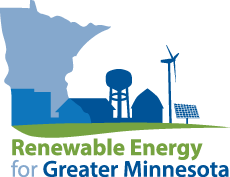This blog post is an excerpt of the original story by Tim Krohn at Mankato Free Press.
Ellen Anderson, who worked for two decades in state government on renewable energy and is now with the University of Minnesota Energy Transition Lab, said the progress on renewables has been breathtaking. “When we first started talking about this, we were told that renewables would never be more than 1 to 3 percent of total (energy generation),” she said. Today 23 percent of total production is from renewables and the state’s goal is for more than 25 percent in the coming years.
Anderson along with Mike Bull, of the Center for Energy and Environment, and Hal Kimball, solar installation specialist with Blue Horizon Energy of Plymouth, spoke to farmers Wednesday at the MN Ag Expo in Mankato. “Wind and solar are now pricing much lower than traditional generation,” Bull said. “There’s a massive transition to renewables in Minnesota.” All three said that right now solar is where it’s at for farmers. “Solar is the most practical and viable option out there now,” Kimball said.
He said that in recent years many farmers have contracted to rent their land for other companies to install large solar gardens. That rent brings about $1,000 per acre each year. But he said a farmer building his on solar panel array with batteries can see $7,000 to $10,000 in energy production each year, using only about one-fifth acre of land.
From CERTs: Click here to learn about model land leases and click here to learn more about installing solar on your own land.
The panel said a variety of financing options (like Property-Assessed Clean Energy) are available to build a solar array and still good tax incentives, although they will begin expiring in coming years. There is a 30 percent federal income tax credit for solar investments. And under the recently passed federal tax bill, farmers can depreciate 100 percent of the project the first year.
There are also U.S. Department of Agriculture renewable energy grants available, although competition for them is stiff. And the group said some farmer co-ops offer assistance programs, and utility companies also have strong solar-purchasing programs.
Anderson said a law called “net metering” requires utilities to buy at retail price any excess power generated by a solar energy system owner. Anderson said that means that even if a farmer’s energy needs drop significantly in the future, they can be assured they can still sell their solar power to keep the cash flow positive during the life of the system.
Beyond individual benefits for farmers, the panel said the rapid growth of solar and other renewables is a big boost to rural economies. Bull said two of the fastest-growing jobs in the country are wind turbine techs and solar installers. Those jobs, he said, start at $40,000 to $50,000.
Click here to read the full article >>
Project Examples in Minnesota |
It’s often useful to learn about what others have done to think about projects that could work for you.
All of the examples below feature renewable energy and energy efficiency projects at Minnesota farms and small businesses.
This article from The Land talks about the rise of solar in particular on Minnesota farms for controlling energy costs.
Farm or Business |
Location |
Technology |
Funding |
Case Study |
| Ronningen Dairy | West Concord | Solar PV | Tax Credits | Learn more |
| Bridgeview Farms | Zumbrota | Solar PV | Made in Minnesota, Tax Credits | Learn more |
| Enchanted Meadows Dairy | La Crescent | Solar PV | REAP, Tax Credits | Learn more |
| Jorgenson Hog Farm | Westbrook | Solar PV, Wind | REAP, Tax Credits | Learn more |
| Featherstone Farm | Rushford | Solar PV | Grant | Learn more |
| Popp Family Farm | Royalton | Solar PV, Wind | REAP, Utility | Learn more |
| Gibbs Dairy | Altura | Solar PV | Utility | Learn more |
| Guentzel Family Farms | Eagle Lake | Solar PV | Tax Credits | Learn more |
| Fuller Family Farm | Trimont | Solar PV, Geothermal | Tax Credits | Learn more |
| Otten Bros. Flower Farm | Delano | Solar PV | PACE | Learn more |
Find out how you can power your farm or business with the Renewable Energy for Greater Minnesota program



